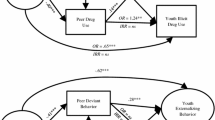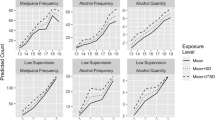Abstract
We examined several models representing the relations among parenting practices, family structure, peer pressure, and drug use in a sample of 443 seventh graders. The setting was an urban school system serving a high percentage of African American students from low-income families. Analyses using structural equation modeling supported a mediation model in which both peer pressure and parenting practices had direct effects on drug use, with peer pressure mediating the influence of parenting. Within this model, family structure had a significant direct effect on parenting, however, contrary to hypotheses, children from two-parent families were more likely to report that they received adequate parenting than were children from single-parent extended families. Several gender differences were also found. Peer pressure was more highly related to drug use for girls than for boys, and the relation between parenting and peer pressure was stronger for boys. Examination of a model that included moderator effects revealed that the relation between peer pressure and drug use increased as a function of poor parenting. Results of our study underscore the importance of drug prevention efforts focused on parenting practices.
Similar content being viewed by others
REFERENCES
Akers, R. L. (1977). Deviant behavior: A social learning approach. Belmont: Wadsworth.
Angel, R., & Tienda, M. (1982). Determinants of extended household structure: Cultural pattern or economic model? American Journal of Sociology, 87 1360-1383.
Bahr, S., Hawks, R., & Wang, G. (1993). Family and religious influences on adolescent substance abuse. Youth and Society, 24 443-465.
Barber, B. K., Olsen, J. E., & Shagle, S. C. (1994). Associations between parental psychological and behavioral control and youth internalized and externalized behaviors. Child Development, 65 1120-1136.
Baron, R. M., & Kenny, D. A. (1986). The moderator-mediator variable distinction in social psychological research: Conceptual, strategic, and statistical considerations. Journal of Personality and Social Psychology, 51 1173-1182.
Bentler, P. M. (1990). Comparative fit indexes in structural equation models. Psychological Bulletin, 107 238-246.
Bentler, P. M. (1992). On the fit of models to covariances and methodology to the Bulletin. Psychological Bulletin, 112 400-404.
Bentler, P. M., & Bonett, D. G. (1980). Significance tests and goodness of fit in the analysis of covariance structures. Psychological Bulletin, 88 588-606.
Cohen, J. (1977). Statistical power analysis for the behavioral sciences (Rev. ed.). New York: Academic Press.
Cohen, J., & Cohen, P. (1983). Applied multiple regression/correlation for the behavioral sciences (2nd ed.). Hillsdale, NJ: Erlbaum.
Dishion, T., Capaldi, D., Spracklen, K., & Li, F. (1995). Peer ecology of male adolescent drug use. Development and Psychopathology, 7 803-824.
Dishion, T., & Loeber, R. (1985). Adolescent marijuana and alcohol use: the role of parents and peers revisited. American Journal of Drug and Alcohol Abuse, 11 11-25.
Dornbusch, S., Carlsmith, J., Bushwall, S., Ritter, P., Leiderman, H., Hastorf, A., & Gross, R. (1985). Single parents, extended households and the control of adolescents. Child Development, 56 326-341.
Dupre, D., Miller, W., Gold, M., & Rospenda, K. (1995). Initiation and progression of alcohol, marijuana, and cocaine among adolescent abusers. American Journal on Addictions, 4 43-48.
Elliott, D. S., Huizinga, D., Ageton, S. S. (1985). Explaining delinquency and drug use. Beverly Hills: Sage.
Farrell, A. D. (1999). Statistical methods in clinical research. In P. C. Kendall, J. H. Butcher, & G. H. Holmbeck (Eds.), Handbook of research methods in clinical psychology (2nd ed., pp. 72-106), New York: Wiley.
Farrell, A. D. (1994). Structural equation modeling with longitudinal data: Strategies for examining group differences and reciprocal relationships. Journal of Consulting and Clinical Psychology, 62 477-487.
Farrell, A. D., & Danish, S. J. (1993). Peer drug associations and emotional restraint: Causes or consequences of adolescents' drug use? Journal of Consulting and Clinical Psychology, 61 327-334.
Farrell, A. D., Danish, S. J., & Howard, K. (1991). Evaluation of data screening methods in surveys of adolescents' drug use. Psychological Assessment, 3 295-298.
Farrell, A. D., Danish, S. J., & Howard, K. (1992). Risk factors for drug use in urban adolescents: Identification and cross-validation. American Journal of Community Psychology, 20 263-286.
Farrell, A. D., Kung, E. M., White, K. S., & Valois, R. (2000). The structure of self-reported aggression, drug use, and delinquent behaviors during early adolescence. Journal of Clinical Child Psychology, 29 282-292.
Farrell, A. D., Meyer, A., & Dahlberg, L. (1996). Richmond Youth Against Violence: A school-based program for urban adolescents. American Journal of Preventative Medicine, 12 13-21.
Farrell, A. D., & White, K. S. (1998). Peer influences and drug use among urban adolescents: Family structure and parent-adolescent relationship as protective factors. Journal of Consulting and Clinical Psychology, 66 248-258.
Fischer, L., & Bauman, K. (1988). Influence and selection in the friend-adolescent relationship: Findings from studies of adolescent smoking and drinking. Journal of Applied Social Psychology, 18 289-314.
Forehand, R., Miller, K., Dutra, R., & Chance, M. (1997). Role of parenting in adolescent deviant behavior: Replication across and within two ethnic groups. Journal of Consulting and Clinical Psychology, 65 1036-1041.
Frick, P. J. (1991). The Alabama Parenting Questionnaire. Unpublished rating scale. University of Alabama.
Galambos, N. L., & Maggs, J. L. (1991). Out-of-school care of young adolescents and self-reported behavior. Developmental Psychology, 27 644-655.
Hawkins, J. D., Catalano, R. F., & Miller, J. Y. (1992). Risk and protective factors for alcohol and other drug problems in adolescence and early adulthood: Implications for substance abuse prevention. Psychological Bulletin, 112 64-105.
Hayduk, L. A. (1987). Structural equation modeling with LISREL. Baltimore: Johns Hopkins.
Hetherington, E. M. (1989). Coping with family transitions: Winners, losers, and survivors. Child Development, 60 1-14.
Hirschi, T. (1969). Causes of delinquency. Berkeley, CA: University of California Press.
Holmbeck, G. N. (1997). Toward terminological, conceptual, and statistical clarity in the study of mediators and moderators: Examples from the child-clinical and pediatric psychology literatures. Journal of Consulting and Clinical Psychology, 4 599-610.
Hundleby, J. D., & Mercer, G. W. (1987). Family and friends as social environments and their relationship to young adolescents' use of alcohol, tobacco, and marijuana. Journal of Marriage and the Family, 49 151-194.
Jaccard, J., & Wan, C. K. (1995). Measurement error in the analysis of interaction effects between continuous predictors using multiple regression: Multiple indicator and structural equation approaches. Psychological Bulletin, 117 348-357.
Jaccard, J., & Wan, C. K. (1996). LISREL approaches to interaction effects in multiple regression. Thousand Oaks, CA: Sage.
Johnston, L. D., O'Malley, P., & Bachman, J. (1996). National survey result from the Monitoring the Future Study, 1991-1995. Rockville, MD: National Institute of Drug Abuse, U.S. Department of Health and Human Services.
Jöreskog, K., & Sörbom, D. (1993). LISREL VIII. Chicago: Scientific Software.
Kandel, D. B., Yamaguchi, K., & Chen, K. (1992). Stages of progression in drug involvement from adolescence to adulthood: Further evidence for the gateway theory. Journal of Studies on Alcohol, 447-457.
Kellam, S. G., Adams, R., Brown, C., & Ensminger, M. E. (1982). The long-term evolution of the family structure on teenage and older mothers. Journal of Marriage and the Family, 44 539-554.
Kishton, J. M., & Widaman, K. F. (1994). Unidimensional versus domain representative parceling of questionnaire items: An empirical example. Educational and Psychological Measurement, 54 757-765.
Lamborn, S., Dornbusch, S., & Steinberg, L. (1996). Ethnicity and community context as moderators of the relation between family decision making and adolescent adjustment. Child Development, 67 283-301.
Liu, X., & Kaplan, H. B. (1996). Gender related differences in circumstances surrounding initiation and escalation of alcohol and other substance use/abuse. Deviant Behavior, 17 71-106.
Metzler, C. W., Biglan, A., Ary, D., & Li, F. (1998). The stability and validity of early adolescent's reports of parenting constructs. Journal of Family Psychology, 12 600-619.
Needle, R., McCubbin, H., Lorence, J., & Hochhauser, M. (1986). Reliability and validity of adolescent self-reported drug use in a family-based study:Amethodological report. The International Journal of the Addictions, 18 901-912.
Oetting, E. R., & Beauvais, F. (1986). Peer cluster theory: Drugs and the adolescent. Journal of Counseling and Development, 65 17-22.
Oetting, E. R., & Beauvais, F. (1990). Adolescent drug use: Findings of national and local surveys. Journal of Consulting and Clinical Psychology, 58 385-394.
Patterson, G. R. (1982). A social learning approach, III: Coercive family process. Eugene, OR: Castalia.
Patterson, G. R., & Stouthamer-Loeber, M. (1984). The correlation of family management practices to delinquency. Child Development, 55 1299-1307.
Robins, L., Helzer, J., & Przybeck, T. (1986). Substance abuse in the general population. In J. Barrett & R. Rose (Eds.), Mental disorders in the community: Progress and challenges. New York: Guilford.
Schaefer, E. S. (1965). Children's report of parental behavior: An inventory. Child Development, 36 417-424.
Shelton, K. K., Frick, P. J., & Wootton, J. (1996). Assessment of parenting practices in families of elementary school-age children. Journal of Clinical Child Psychology, 25 317-329.
Smith, C., & Krohn, M. (1995). Delinquency and family life among male adolescents: The role of ethnicity. Journal of Youth and Adolescence, 24 69-93.
Steinberg, L., Fletcher, A., & Darling, N. (1994). Parental monitoring and peer influences on adolescent substance use. Pediatrics, 93 1060-1064.
Steinberg, L., & Silverberg, S. (1986). The vissitudes of autonomy in early adolescence. Child Development, 57 841-851.
Wells, L. E., & Rankin, J. H. (1988). Direct parental controls and delinquency. Criminology, 26 263-285.
Zimmerman, M. A., Salem, D. A., & Maton, K. I. (1995). Family structure and psychosocial correlates among urban African-American adolescent males. Child Development, 66 1598-1613.
Author information
Authors and Affiliations
Rights and permissions
About this article
Cite this article
Kung, E.M., Farrell, A.D. The Role of Parents and Peers in Early Adolescent Substance Use: An Examination of Mediating and Moderating Effects. Journal of Child and Family Studies 9, 509–528 (2000). https://doi.org/10.1023/A:1009427010950
Issue Date:
DOI: https://doi.org/10.1023/A:1009427010950




